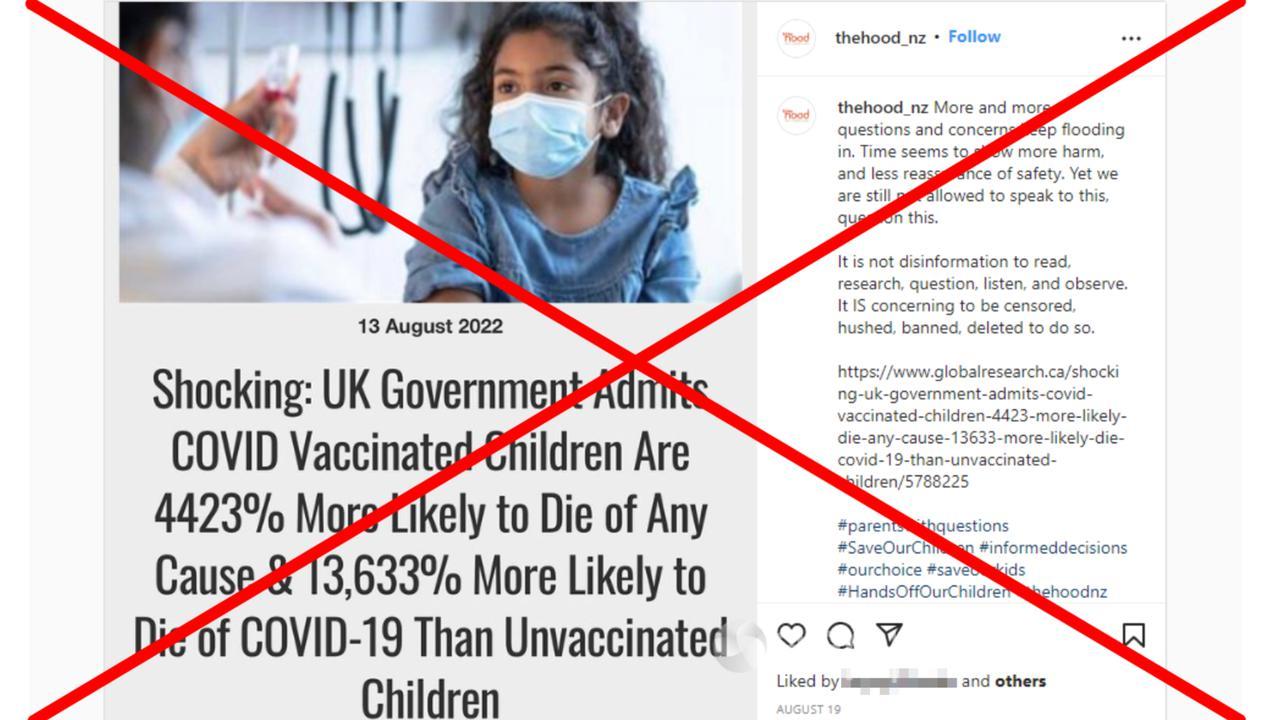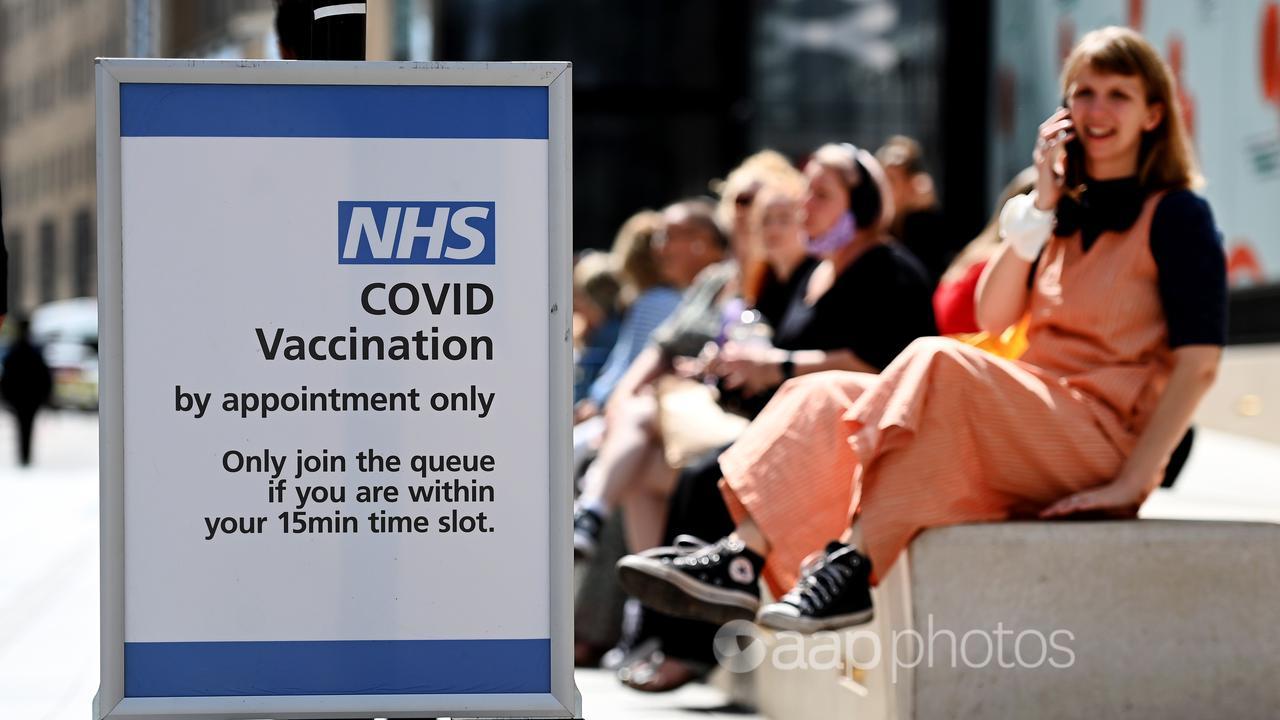A New Zealand group, which advocates against COVID-19 jabs for children, claims in a social media post that data shows vaccinated children in England are 13,633 per cent more likely to die with COVID-19 compared to unvaccinated children.
The claim is misleading. Experts say the data analysis used in the claim does not account for the high-risk health status of children who had been fully vaccinated.
In an Instagram post, the group said: “Shocking: UK Government Admits COVID Vaccinated Children Are 4423% More Likely to Die of Any Cause & 13,633% More Likely to Die of COVID-19 Than Unvaccinated Children.”

The post includes a link to the claim’s source, a July 27 article from a website called The Exposé, a misinformation platform which has previously misused official data to make false claims about COVID-19.
The article said its claim was based on ‘deaths by vaccination status‘ data from the UK’s Office for National Statistics (ONS). The dataset included details of deaths in England for the 17-month period between January 1, 2021, and May 31, 2022.
The ONS dataset included mortality rates for adults – calculated as the number of deaths per 100,000 person-years – but the article claimed mortality rates for children aged 10-14 years were intentionally omitted.
“Unfortunately for the ONS… they still provide us with enough information for us to calculate the mortality rates ourselves,” the article said.
It goes on to provide its own mortality rate figures for 10 to 14-year-olds, claiming the calculations show death rates went “from bad to worse following the administration of each injection”.
“The all-cause death mortality rate equates to 97.28 among double-vaccinated children, and a shocking 289.02 per 100,000 person-years among triple-vaccinated children,” the article said.
“This means, according to the UK Governments (sic) own official data, double vaccinated children are 1422% / 15.22x more likely to die of any cause than unvaccinated children … triple vaccinated children are 4423% / 45.23x more likely to die of any cause than unvaccinated children.”
However, an ONS spokesman told AAP FactCheck that child COVID-19 mortality rates were not meaningful because of the way children at risk of serious ill-health were prioritised in the vaccine rollout.
“For the bulk of the period (January to October 2021), only clinically vulnerable children were allowed to receive the COVID-19 vaccine, and clinically vulnerable young people were vaccinated much earlier than those with no comorbidities,” the ONS spokesman said in an email.
“Clinically vulnerable children and young people have a higher mortality rate than those with no comorbidities, and this explains why vaccinated teenagers have higher rate of death than those who remained unvaccinated.”
As explained here, the ONS uses “person-years” in its data instead of “number of people” because the number in each group is fluid, dependent on changing vaccination status.
“For example, if someone was unvaccinated for 3 months when they had a first dose, and then 6 months later had a second dose, they would contribute 0.25 person years to the unvaccinated total, 0.5 to the first dose groups and 0.25 to the second dose groups,” the ONS wrote in March 2022.
Professor David Spiegelhalter, chair of the Winton Centre for Risk and Evidence Communication at Cambridge University, said the article’s data analysis was unfairly skewed because it did not allow for the fact children in England under 15 were not routinely vaccinated.
“The only ones to get boosters are at high-risk, i.e. they have serious health conditions,” Prof Spiegelhlater told AAP FactCheck in an email.
“We can therefore expect the very few who get vaccinated to be very vulnerable.”
Prof Spiegelhalter said the article’s calculations were based on very small numbers of deaths across all vaccination statuses within the 10-14 age group.
For example, only one COVID-19 death and six non-COVID deaths were recorded among triple-vaccinated children in that age group.

The article also appears to have wrongly transcribed one of it own figures in its final graph, leading it to falsely claim a mortality rate of 2.83 deaths per 100,000 person-years for triple-vaccinated teenagers aged 15-19 years.
The Exposé’s calculations elsewhere in the article put this figure at 0.62 deaths per 100,000 person-years.
The article used the wrongly transcribed figure to conclude triple-vaccinated 15 to 19-year-olds were “136% / 2.35x more likely to die of Covid-19 than unvaccinated teenagers”.
However, correcting for the transcription error should have led the article to conclude triple-vaccinated 15 to 19-year-olds were about half as likely to have died with COVID-19, when compared to unvaccinated people in the same age group – not more than twice as likely, as the article claimed.
Professor Sheila Bird, from the MRC Biostatistics Unit at Cambridge University, also told AAP FactCheck the article’s data analysis was flawed.
“Beware age-difference and selection bias in those children who have/have not been vaccinated,” Prof Bird said in an email.
“Not all ages are offered COVID-19 vaccine.”
Similar misleading claims about child mortality in England have been debunked here and here.
The Verdict
The claim vaccinated children in England are more likely to die with COVID-19 is misleading. The interpretation of the data is flawed because it fails to account for the fact only vulnerable children at higher risk of serious illness received COVID-19 vaccines for most of the period under review.
Statistics experts and the UK’s Office of National Statistics say for this reason, mortality rates for vaccinated and unvaccinated children are not meaningful and cannot be compared the way the post suggests.
Misleading – The claim is accurate in parts but information has also been presented incorrectly, out of context or omitted.
* AAP FactCheck is an accredited member of the International Fact-Checking Network. To keep up with our latest fact checks, follow us on Facebook, Twitter and Instagram.
All information, text and images included on the AAP Websites is for personal use only and may not be re-written, copied, re-sold or re-distributed, framed, linked, shared onto social media or otherwise used whether for compensation of any kind or not, unless you have the prior written permission of AAP. For more information, please refer to our standard terms and conditions.


















